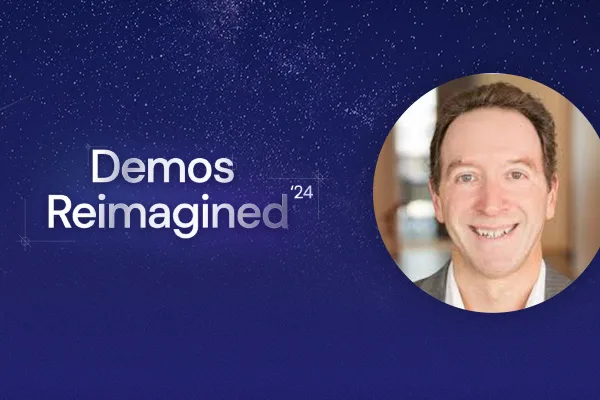Accelerate deals and increase win rates with the leading enterprise demo platform.
David Yockelson: How Interactive Demos Drive Sales

February 12, 2025
Table of Contents
At last week’s Demos Reimagined event, Gartner VP Distinguished Analyst David Yockelson gave his take on how interactive demo technology can transform the go-to-market (GTM) process for software companies. As co-author of the 2024 Market Guide for Interactive Demonstration Applications, Yockelson is the top expert in this quickly maturing technology sector. He shared a roadmap on using demo technology to shorten sales cycles, improve the buyer experience, and streamline the go-to-market (GTM) approach. Most importantly, he cleared up which types of interactive demo tech are best for different use cases.
The key takeaway: When choosing a vendor, select one that aligns with your tactical needs today, but also think strategically about how you can scale to support multiple use cases over time.
Let’s look at some of the GTM challenges Yockelson outlined in his session, along with how to address them with the right kind of interactive demo technology. If you want to listen to his entire session, watch it on-demand here.
Top GTM and Demo Challenges for SaaS Companies
Modern buyers demand a mix of self-service and high-touch interactions, which begs the question: Is a sales-led or product-led approach most effective? Yockelson noted that traditional sales-led approaches can result in average sales cycles of 10 months, as sales reps navigate complex sales and growing buying committees. To contrast, Product-Led Growth (PLG) aims to simplify sales by enabling customers to experience products directly. It, too, has challenges, as not all products are suitable for self-service trials or freemium experiences. Even so, PLG serves the need for prospects to research on their own without extensive sales involvement, which many buyers now prefer. The truth remains somewhere in the middle with hybrid PLG becoming a much more common GTM approach.
In both self-service and high-touch models, old ways of demoing are inefficient and ineffective. Yockelson noted that the “Request a Demo” button is one of the top-performing and most used calls-to-action on websites. While companies rely on it to showcase product value, most prospects don’t like jumping through hoops before they can experience the product for themselves. He added that live demos can also be a bottleneck. Traditional demo processes require team members to schedule and build live demos from scratch, which limits the number of prospects that sales teams can reach and significantly prolongs the sales cycle.
That’s where companies can rely on interactive demos to streamline their demo creation processes and show value sooner
The Massive Potential of Interactive Demos
Yockelson outlined how interactive demo technology can aid self-service buyers, while still supporting high-touch sales-led use cases. Interactive demos can function as valuable pieces of marketing content, which sales and marketing teams can integrate into campaigns and share broadly. At the same time, interactive demos collect engagement data, providing sales teams with insights into buyer interest and intent. This information helps reps personalize follow-up conversations with demos and prioritize high-interest prospects.
Interactive demos can look like either self-guided experiences or live demos. Demo technology in this category varies greatly, and ultimately the technology you choose depends on your organization’s GTM needs. Yockelson added that not all of them work best in all buying situations. Yet overall, interactive demos are quicker, easier, less risky, and more cost effective than traditional demo approaches, such as demoing in a live production environment.
Yockelson remarked that he hasn’t seen a technology like interactive demos that have such immediate and apparent efficacy. Depending on the use case, he’s seen examples of interactive demos reducing customer acquisition costs, increasing deal velocity, and saving time and resources on demo prep. Here are some of the quantifiable benefits of interactive demos he shared.
Choosing the right interactive demo technology for your use case
Yockelson highlighted five different types of interactive demo technologies available today. He noted that some vendors offer their customers multiple ways to demo.
- Interactive video: Offers a self-paced, video-based journey where users pick paths that most interest them. It’s simple to set up and ideal for initial exploration.
- Screen capture/HTML edit: Allows a storyboard-like product walkthrough with added hotspots and guidance, giving more control over how specific features are highlighted. In some cases, these screen captures are editable for minor customization (e.g. changing names and pictures).
- HTML/CSS cloning: Creates higher-fidelity demos created by capturing an application’s front-end. These technologies typically feature a portion of the entire application, and enable the team to make edits to the interface, allowing for a realistic product experience.
- Full application cloning/sandbox: Offers a sandbox-like environment without guardrails, so sales teams can walk through whatever feature/functionality the prospect wants to see in the application. Some of these technologies offer synthetic data injection capabilities to customize data to the prospect.
- Overlay/synthetic data: Gives the ability to overlay a live production application with synthetic data to customize data for each customer. While this has some of the risks of demoing a live application, it allows the team to customize the application to a specific prospect.
He added that some demo technology helps showcase backend functionalities (like APIs) to tech-savvy buyers who need an in-depth look at the product’s capabilities.
Yockelson recommended lower fidelity approaches like interactive videos and screen capture demos for top-of-funnel interactions with self-service buyers. They tend to be faster and easier to create, which is good for marketers with limited technical resources. To contrast, in a live sales demo setting, organizations should favor a higher fidelity, customizable approach that looks and feels more like the real product. Buyers at this stage tend to be at the bottom of the funnel and close to decision-making, so they will want to see more of the product’s features and functionality. Your team’s technical capabilities are also a key consideration. For example, HTML/CSS and full application cloning may be a better option for live demoing for teams with limited technical resources.
Choosing an Interactive Demo Technology that Spans Stakeholders and Use Cases
To close, Yockelson advised buyers to be smart about understanding their demo use cases. Interactive demo technology often must meet the needs of multiple stakeholders. Once one team learns about the benefits of creating more efficient and effective demos, the technology’s impact tends to go viral across other departments in the organization. Here are some of the use cases he highlighted for different stakeholders.
Overall, when selecting a demo creation technology, Yockelson recommended choosing vendors with longevity, enterprise-readiness, and proven success with similar use cases. Think about which demo creation methods and use cases you need to support most now, and what you may need in the future. Demo customization and management features are also a key consideration. Choosing a vendor that simplifies the demo creation and distribution process is key, especially for companies with limited technical resources.
Yockelson noted that the technology should ideally reduce the burden on presales teams, making it easier to create and scale demos across multiple buyer personas and industries. He added that the use of demo centers (or demo libraries) is on the rise, where multiple stakeholders can reuse and repurpose demo assets developed by the presales team. Finally, he noted that the ability to create synthetic data was incredibly important to delivering demos in context with the prospect’s needs and pain points.
His parting words were to buy and implement tactically to meet your needs, but select strategically to scale and support multiple use cases.
Want even more ways to navigate the complex demo tech market?
Check out the 2024 Market Guide for Interactive Demonstration Applications






